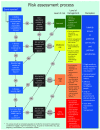Regional event-based surveillance in WHO's Western Pacific Region
- PMID: 33537160
- PMCID: PMC7829081
- DOI: 10.5365/wpsar.2018.9.5.009
Regional event-based surveillance in WHO's Western Pacific Region
Abstract
In the World Health Organization's Western Pacific Region, event-based surveillance has been conducted for more than a decade to rapidly detect and assess public health events. This report describes the establishment and evolution of the Western Pacific Region's event-based surveillance system and presents an analysis of public health events in the Region. Between July 2008 and June 2017, a total of 2396 events were reported in the Western Pacific Region, an average of 266 events per year. Infectious diseases in humans and animals accounted for the largest proportion of events recorded during this period (73%, 1743 events). Maintaining and strengthening this well established system is critical to support the rapid detection, assessment and response to public health events to sustain regional health security.
(c) 2020 The authors; licensee World Health Organization.
Figures




References
-
- Thirteenth general programme of work, 2019–2023: promote health, keep the world safe, serve the vulnerable. Geneva: World Health Organization; 2019. Available from: https://apps.who.int/iris/handle/10665/324775, accessed 3 February 2020.
-
- International Health Regulations. (2005), third edition. Geneva: World Health Organization; 2005. Available from: https://apps.who.int/iris/handle/10665/246107, accessed 3 February 2020.
-
- A guide to establishing event-based surveillance. Manila: World Health Organization Regional Office for the Western Pacific; 2008. Available from: https://apps.who.int/iris/handle/10665/207737, accessed 3 February 2020.
MeSH terms
Grants and funding
LinkOut - more resources
Full Text Sources
Medical
